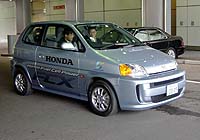
 |
| A reporter takes Honda Motor Co.'s FCX fuel-cell vehicle for a test spin at the automaker's headquarters in Tokyo. KAHO SHIMIZU PHOTO |
A recent announcement by Honda Motor Co. to lease a fuel-cell vehicle to an individual driver and the government's approval last month of fuel-cell vehicles developed by Honda and Toyota Motor Corp. marked significant steps in their 10-year-plus quest.
Experts and industry officials say widespread use of the dream vehicle in the near future is no longer a fantasy, but at the same time they point out that automakers need to clear the remaining hurdles as soon as possible to keep up the momentum.
Last week, American Honda Motor Co. signed a two-year leasing contract with the family of Jon Spallino in California to use its FCX fuel-cell car for $500 a month, making Honda the first automaker in the world to deliver its FCV to an individual customer.
Honda's and Toyota's pollution-free FCVs in mid-June became the first to receive motor-vehicle type certification from the Japanese government, paving the way for mass production and marketing.
"By having individual customers drive in a real-world situation, the carmakers will be able to get feedback, which will be used" to further improve the technology, said Hisashi Ishitani, a system and control engineering professor at Keio University.
"It shows that FCVs can drive like a conventional car, and now they have entered the stage for further technological improvements," he said.
FCVs are powered by electricity generated through a chemical reaction between hydrogen and oxygen, releasing water vapor as a byproduct.
All new vehicles have to gain approval from the Land, Infrastructure and Transport Ministry for public sale. Gaining the motor-vehicle type certification means the FCVs have cleared the government's safety and environmental standards.
Before that, the two automakers had to gain approval on a vehicle-by-vehicle basis, meaning their use was limited to registered parties for the purpose of testing on public roads.
The safety standards mainly center on the technology to prevent leakage of high-pressure hydrogen during collisions and to ensure passenger safety in terms of the cars' electrical systems.
Once its hydrogen tank is filled, Toyota's new FCHV can travel up to 330 km, compared to the 300 km of the previous model, released in 2002, and it has 12.5 percent more output from the motor at 90 kw.
Honda's FCX meanwhile has a range of 430 km and a 80-kw motor output.
Having gained certification, Toyota will start leasing its remodeled FCHV fuel-cell hybrid vehicles this month, mainly to government offices and municipalities for a monthly fee of 1.05 million yen over a 30-month period.
Apart from the Spallino family, Honda has already leased 19 FCX fuel-cell cars mainly to government offices and municipalities in Japan and the U.S. since December 2002 for 800,000 yen a month.
Toyota has leased 16 FCHV in the two countries since December 2002.
Their lease prices reflect the two carmakers' strong wish to attract customers.
"Because the FCVs are so expensive, it will be unrealistic to set the price based on trying to break even," said Yozo Kami, an executive chief engineer at Honda R&D Co. He added that even if it doesn't pay, the pricing reflects Honda's emphasis on promoting its FCVs.
But neither automaker has decided yet to lease their FCVs to individual drivers in Japan.
Honda officials said it is easier for the automaker to start leasing in the U.S. because there are more hydrogen gas installations there than in Japan.
Currently, only 13 hydrogen gas stations exist throughout Japan, compared with about 15 in California alone, which is one of the most advanced U.S. states in terms of hydrogen installations.
There are also many hurdles that must be cleared before the environment-friendly vehicles truly find their way to ordinary drivers, experts say.
One is the high cost of building the hydrogen-fed vehicle, which is reportedly more than 100 million yen.
"To make (FCVs) able to compete against conventional gasoline-powered vehicles, we have to slash prices to at least 1/100th of the current levels," said Honda's Kami. "But the prospect of this kind of price reduction is far from certain."
Yet at the same time Kami feels a sense of urgency about lowering the cost, saying that if automakers are unable to market FCVs at 3 million yen to 4 million yen by 2020, fuel-cell technology will be a failure in terms of marketability.
Toyota officials agree with that time frame but are not that optimistic.
"An FCV is the closest to what we believe is the ultimate clean car," but widespread use by individual drivers means that its price, convenience and performance should equal that of conventional gasoline-powered cars, said Toyota spokeswoman Yurika Motoyoshi. "Reducing costs to the level of several million yen is quite difficult."
Keio University's Ishitani said the automakers will not be able to slash prices without another technological breakthrough.
Ishitani said the metals, including platinum, used as catalysts in the stack of fuel cells are too expensive and finding ways to significantly reduce their amount is one major task that must be overcome.
"Simply putting the current FCVs into mass production will not allow automakers to reduce prices," Ishitani said.
The Japan Times: July 7, 2005
(C) All rights reserved